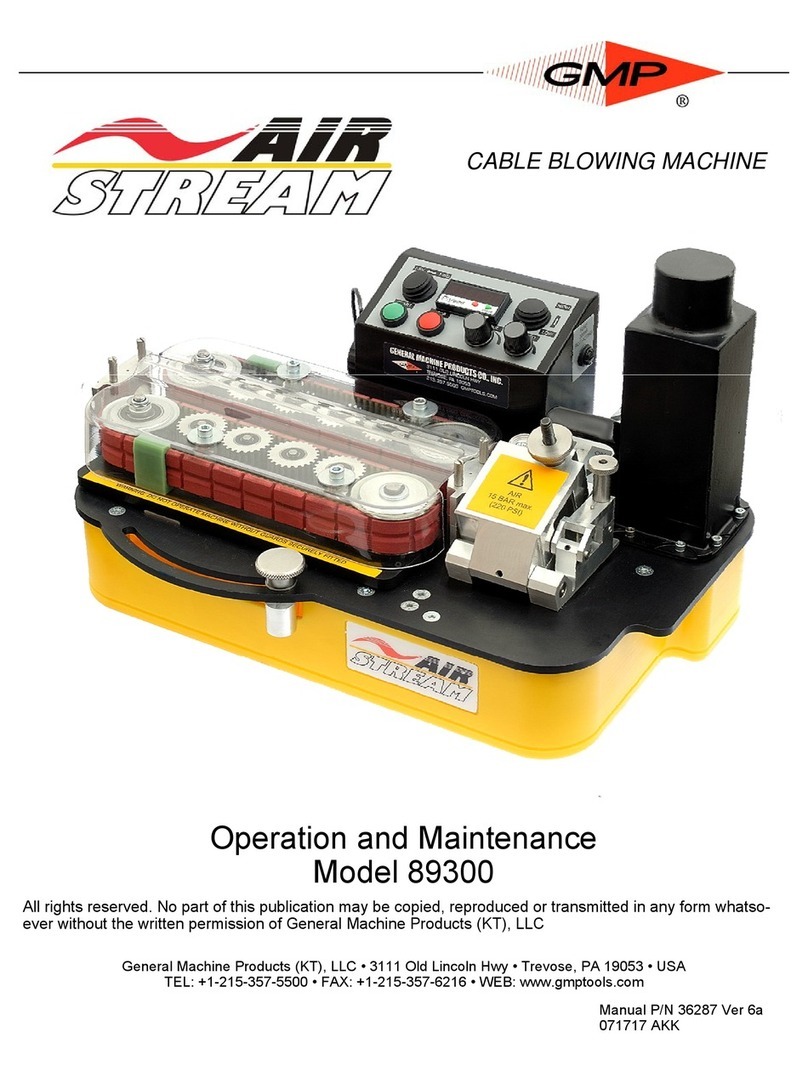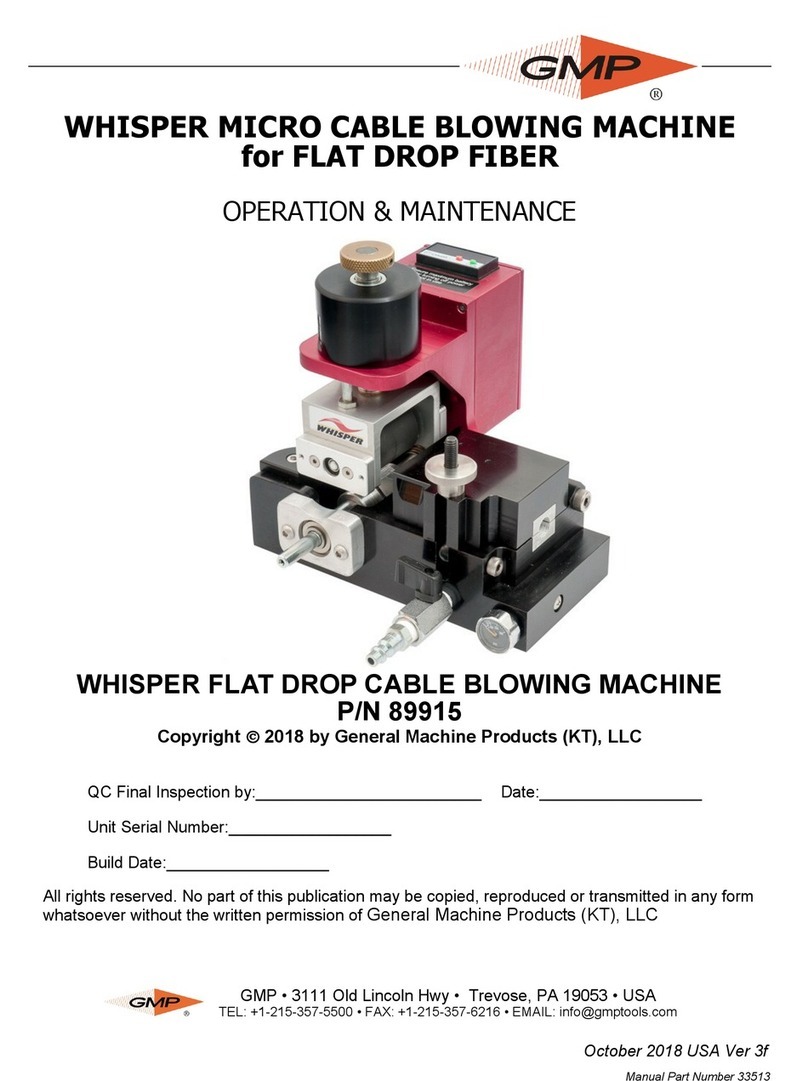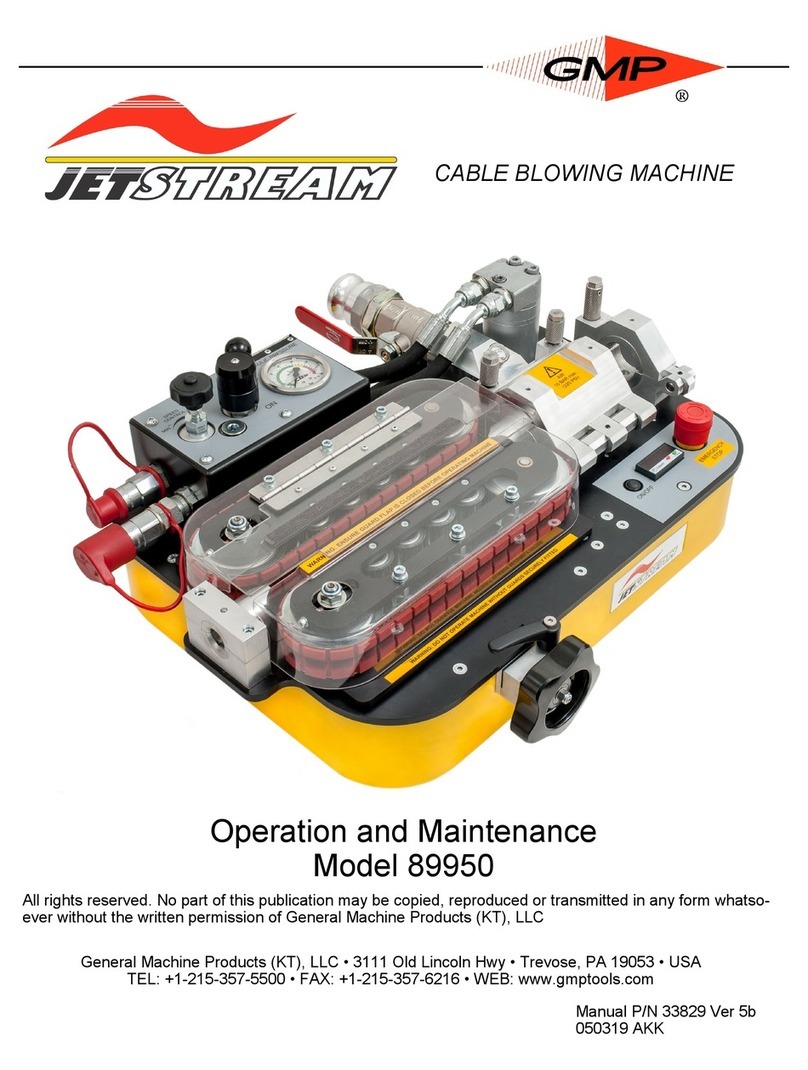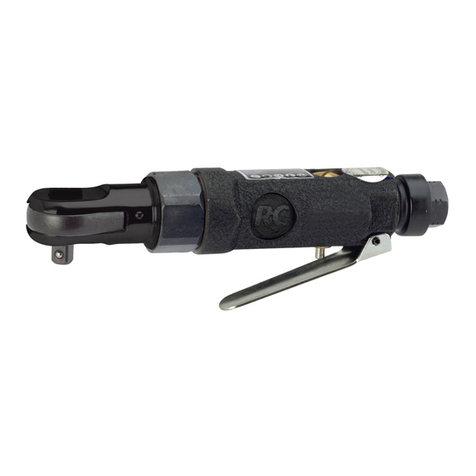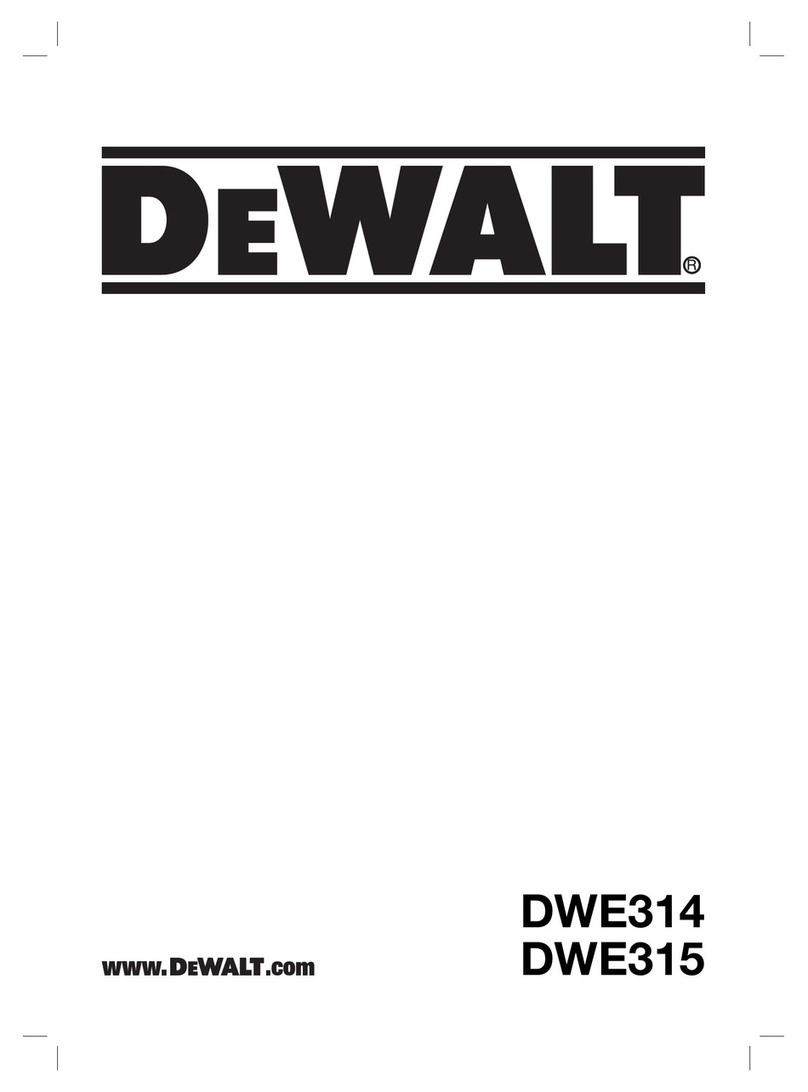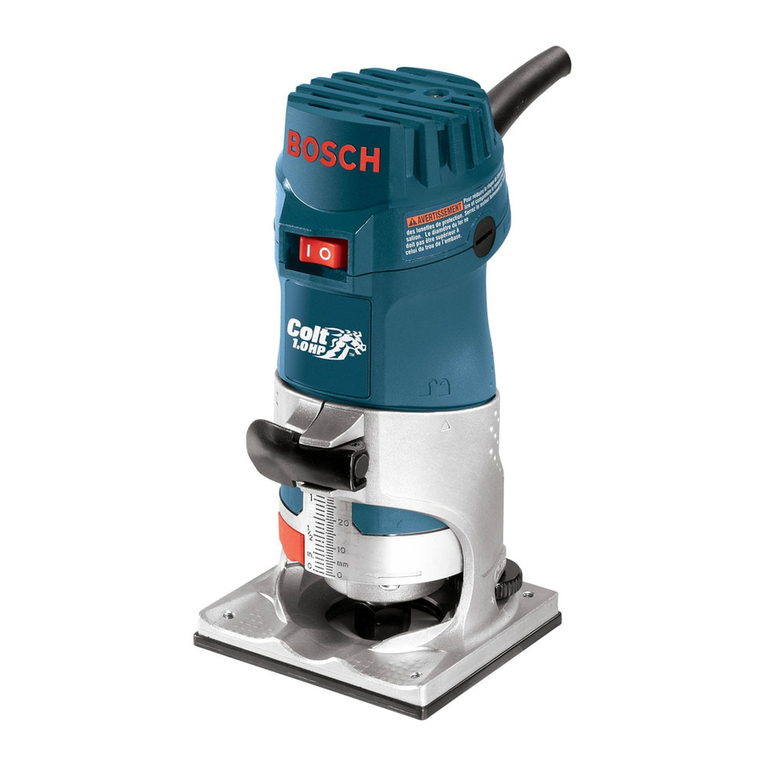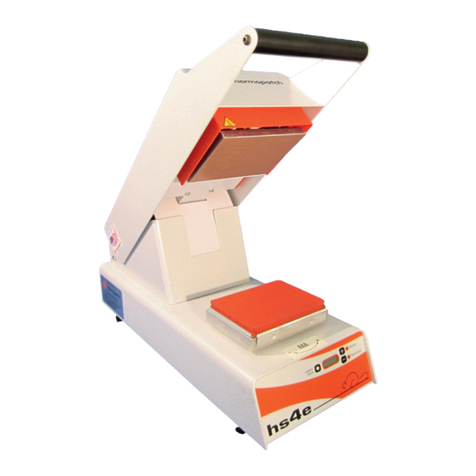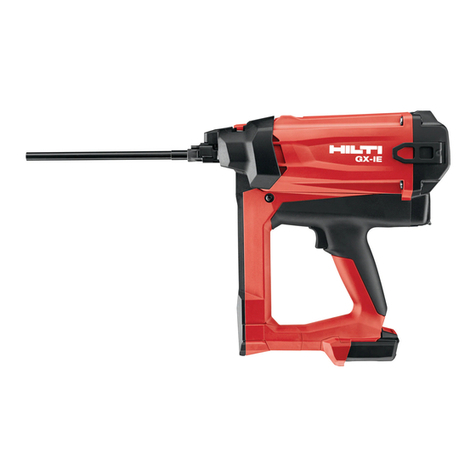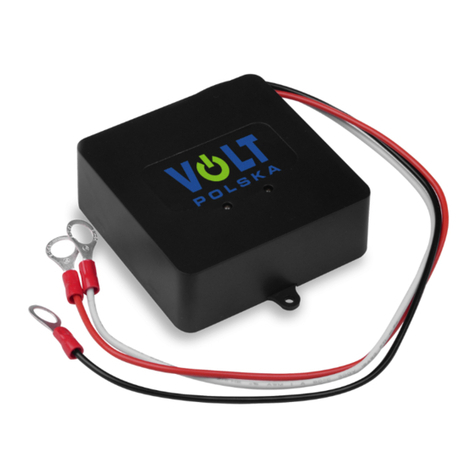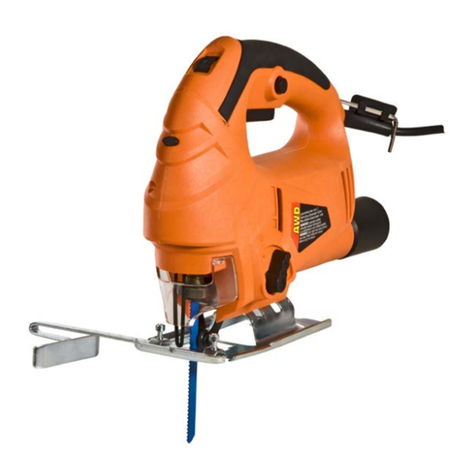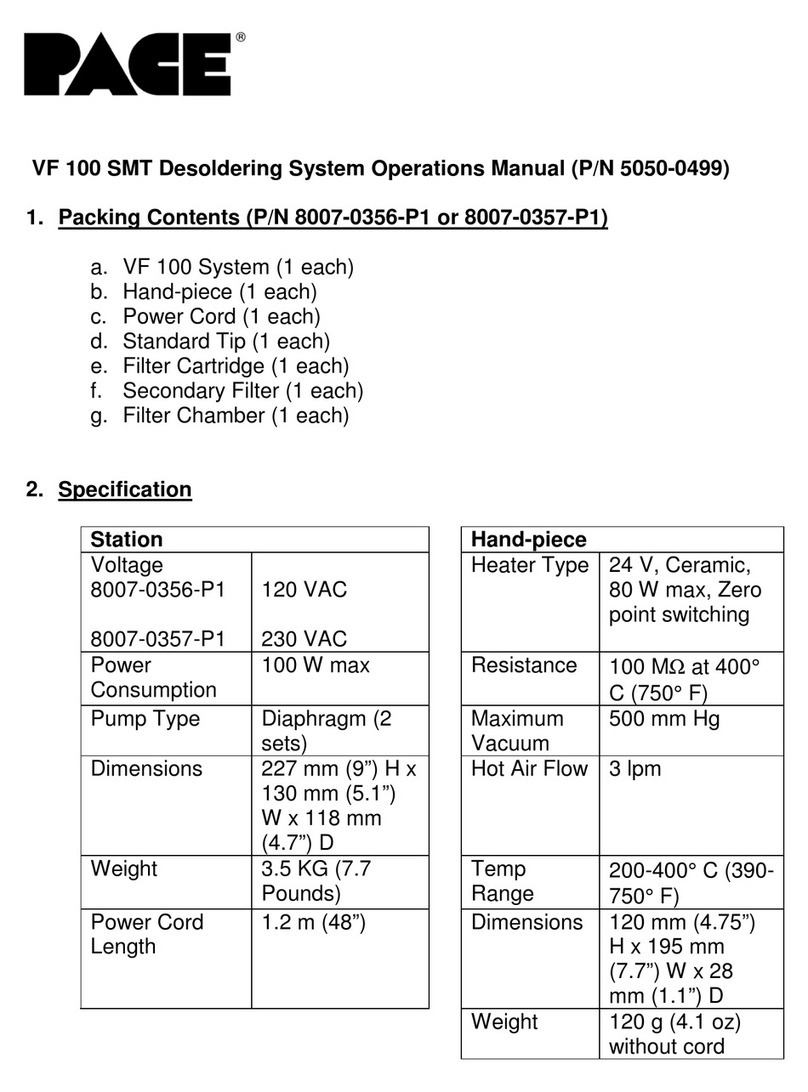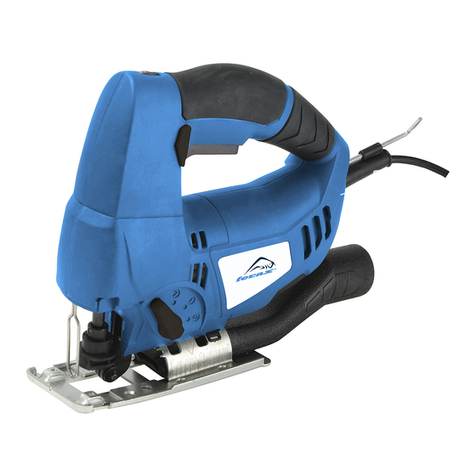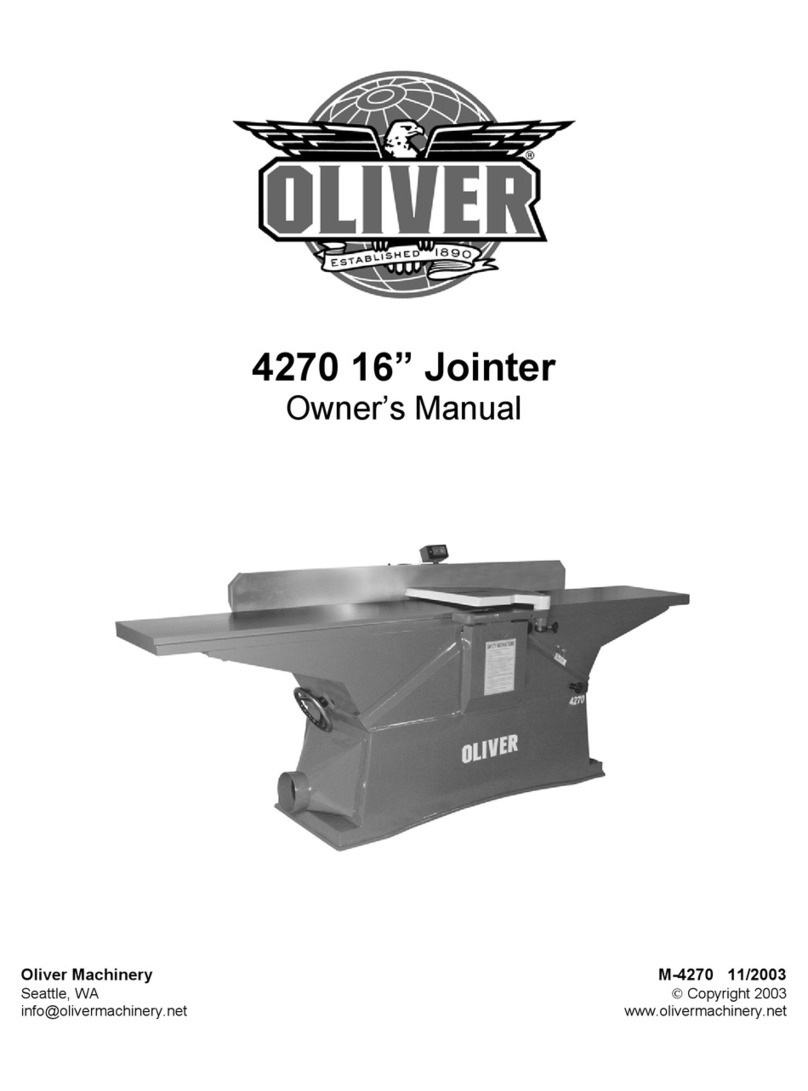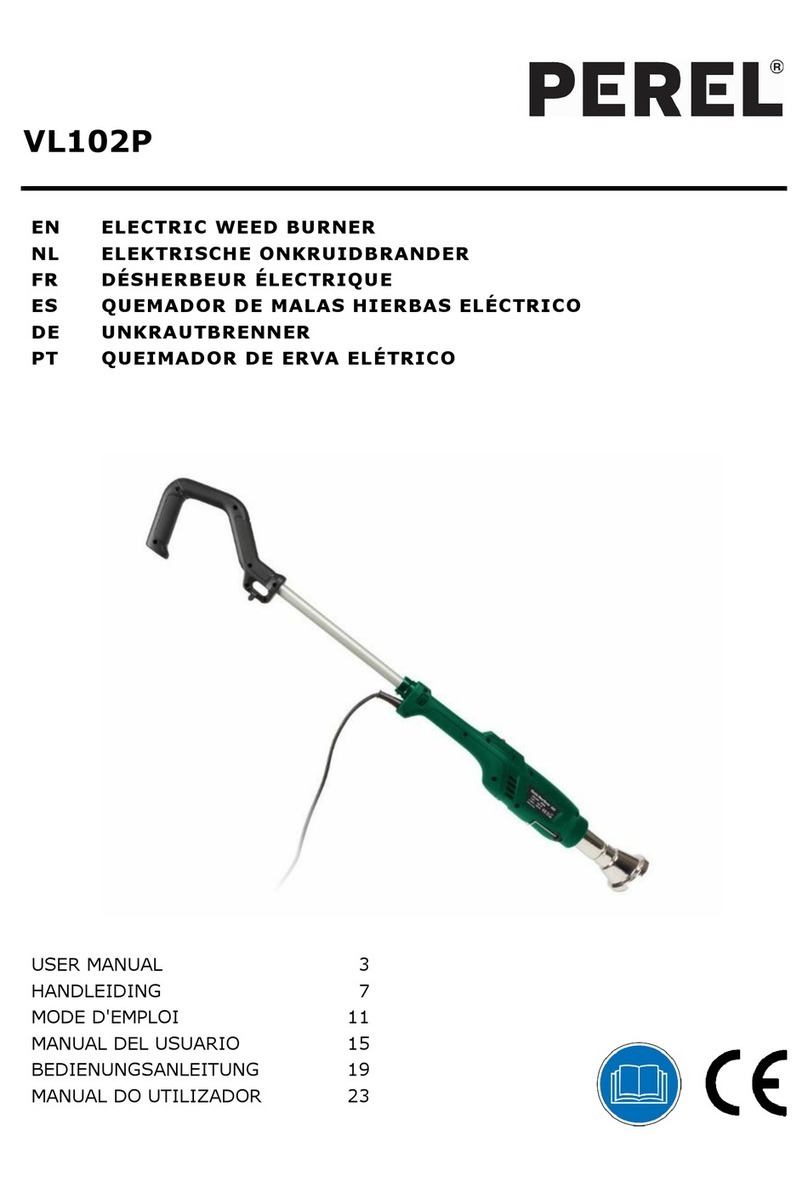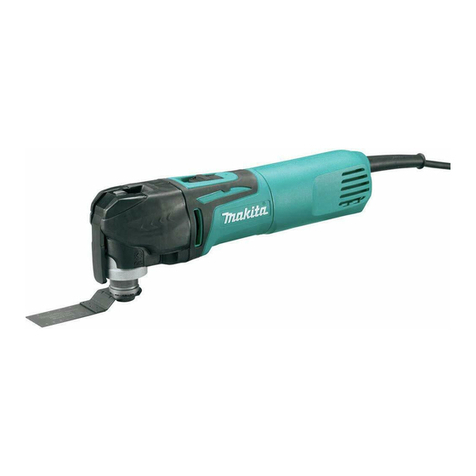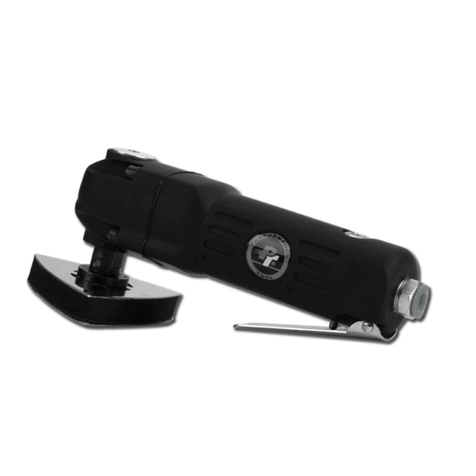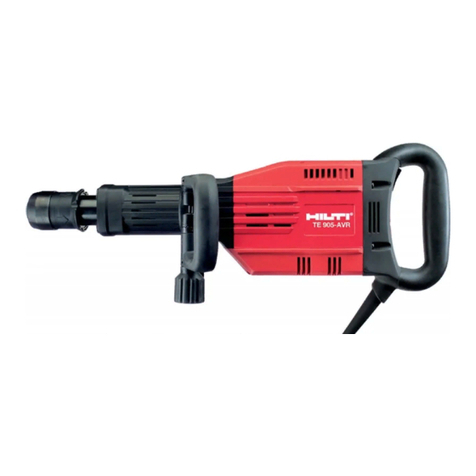GMP HURRICANE Installation guide

Page General Machine Products (KT), LLC
Operation and Maintenance
Model 90000
All rights reserved. No part of this publication may be copied, reproduced or transmitted in any form
whatsoever without the written permission of General Machine Products (KT), LLC
General Machine Products (KT), LLC • 3111 Old Lincoln Hwy • Trevose, PA 19053 • USA
TEL: +1-215-357-5500 • FAX: +1-215-357-6216 • WEB: www.gmptools.com
CABLE BLOWING MACHINE
Manual P/N 34816 Ver 03
04/20/2021 AKK
HURRICANE

Page 2 General Machine Products (KT), LLC
Rev.no Date Details Author
01 04/2020 Original issue A.GRAHAM
02 02/2021 Reformat for US A. Konschak
03 04/2021 Various updates to reflect the production model A. Konschak
REVISION HISTORY:

Page 3 General Machine Products (KT), LLC
CONTENTS
SECTION DESCRIPTION PAGE
1.0 INTRODUCTION 4
2.0 SAFETY INSTRUCTIONS 5
2.1 WORK AREA AND GENERAL SAFETY 5
2.2 GENERAL PNEUMATIC SAFETY INSTRUCTIONS 7
2.3 GENERAL ELECTRICAL SAFETY INSTRUCTIONS 7
3.0 CRITICAL POINTS THAT AFFECT THE CABLE BLOWING MACHINE 7
4.0 GENERAL DESCRIPTION 9
5.0 SPECIFICATION 9
6.0 EQUIPEMENT LAYOUT 10
6.1 BLOWING MACHINE LAYOUT 10
6.2 REMOTE CONTROL LAYOUT 11
7.0 OPERATING PROCEDURE 11
7.1 SETTING UP BLOWING AREA 11
7.2 CHANGING THE DUCT CLAMPS AND CABLE GUIDES 12
7.3 DUCT AND CABLE SET UP 12
7.4 SETTING THE CLAMP FORCE 13
7.5 CONNECT THE AIR SUPPLY TO THE MACHINE 14
7.6 CONNECTING THE REMOTE AND ELECTRICAL SUPPLY 14
7.7 CABLE INSTALLATION 15
7.8 OTHER REMOTE FUNCTIONS 18
7.9 DATA LOGGING 19
8.0 MAINTENANCE 20
8.1 GENERAL 20
8.2 REPLACING THE AIRBOX HOUSING SEAL 21
8.3 CHANGING THE CABLE DRIVE BELTS 21
8.4 TENSIONING THE DRIVE BELTS 22
8.5 CHANGING THE NYLON CABLE GUIDE 23
9.0 MONTHLY SERVICE CHECK LIST 23
9.1 SERVICE HISTORY RECORD 24
10.0 DUCT INTEGRITY 25
10.1 DUCT LUBRICATION 26
11.0 RECOMMENDED SPARES LIST 27
12.0 APPENDIX 1- COLLET AND SEAL LIST 28
13.0 APPENDIX 2- MAIN REMOTE SCREENS 29
13.1 MAIN SCREEN 29
13.2 PRE-INSTALLATION SCREEN 30
13.3 INSTALLATION SCREEN 30
13.4 SETTINGS SCREEN 31
13.5 SYSTEM INFORMATION SCREEN 31
13.6 ENVIRONMENT SCREENS 32
13.7 FILE STORAGE SCREEN 32
14.0 BLOWING ACCESSORIES 33

Page 4 General Machine Products (KT), LLC
Founded by engineer George M. Pfundt in 1936, GMP started opera-
tions in a downtown Philadelphia building as a specialty machine shop
doing work for the local Bell Telephone company and for the electric
utility company. GMP expanded to a production shop after landing a
contract with Western Electric
Company and, subsequently,
forming a close relationship with Bell Telephone
Laboratories in Murray Hill, NJ, which enabled it to
manufacture prototypes of products for experi-
mental use within the Bell System.
GMP's 100,000-square-foot manufacturing plant in
Trevose is equipped with a full complement of
technologically advanced machine tools manned
by a well-trained team of craftspeople. Our own
engineering staff conduct research & development of GMP's products using computer aid-
ed design, a prototype fabrication shop and an on-site testing facility.
In 2004, CBS Products joined forces with GMP to further enhance the global reach and breadth of
our outside plant equipment capabilities. As of June 2017 the business of GMP Tools and CBS
Products were acquired by Klein Tools of the USA. Renamed GMP Products (KT), LLC, we contin-
ue to be the same engineering talent and innovative solution providers.
GMP continues to make investments in new product R&D, state-of the-art manufacturing,
quality assurance, distribution and inventory control techniques, and physical plant, in or-
der to maintain its manufacturing leadership position and its continuing ability to anticipate
and meet the changing needs of
work crews in the field who rely on
the ruggedness, practicality and
safety of GMP equipment. As our
quality policy statement affirms:
"GMP supplies defect-free products
and service, on time, which meet
its customers' expectations."
1.0 INTRODUCTION

Page 5 General Machine Products (KT), LLC
2.0 SAFETY INSTRUCTIONS
THIS EQUIPMENT SHOULD BE USED ONLY BY PERSONNEL WHO HAVE BEEN GIVEN THE
APPROPRIATE TRAINING, AND WHO ARE COMPETENT TO USE IT.
THESE INSTRUCTIONS ARE TO BE MADE AVAILABLE TO OPERATORS OF THIS EQUIPMENT
AT ALL TIMES, FAILURE TO OBSERVE THESE SAFETY INSTRUCTIONS COULD RESULT IN
SERIOUS PERSONAL INJURY AND/OR PROPERTY DAMAGE.
2.1 WORK AREA AND GENERAL SAFETY
1. Read and understand the operation and maintenance manual supplied with this equipment. Keep it in a
convenient place for future reference.
2. Keep children and untrained personnel away from this equipment while in operation.
3. Keep all guards and safety devices in place. Do not operate this equipment with guards removed or
damaged.
4. Keep hands, feet and loose clothing away from moving parts, especially at cable entry points.
5. Always stop the machine and isolate compressed air and electrical services to carry out lubrication and
servicing.
6. Check machine before starting for worn or damaged parts. Check for signs of loose nuts and bolts etc.
7. If machine is left unattended, ensure that unauthorized use is prevented.
8. Never leave the machine unattended while in use.
9. Consider the use of safety barriers, especially when used in public places, observe all statutory require-
ments for working environments.
10. Beware of pinch points involved with rotating components,
11. Beware of hot surfaces, machine uses compressed air.
12. When operating machine always wear appropriate safety clothing, ear defenders, eye protection, hard
hat, safety shoes and leather gloves, machine operates with compressed air at up to 15 Bar.
13. Prior to installation ensure the tube route is connected properly.
14. Beware of exposed electrical contacts. Do not touch, or allow metal objects to come into contact.
15. Machine may cause additional fire hazard if involved in an existing fire due to compressed air.
16. No personnel are to be in manholes or ducts when the Cable Blowing Machine is being operated.
17. The machine must be operated on firm ground.
18. Stay clear of cables or lines under tension.
19. Stay clear of pressurized air line and tube.
20. Only use the machine for its intended purpose, do not use the roller drive without the air chamber to
push or to retrieve cable, blow air in the far end to help cable recovery.
21. Do not place cable drum too close to the Cable Blowing Machine.

Page 6 General Machine Products (KT), LLC
22. The compressed air supply must not be allowed to enter the air chamber or tube before the rollers
have been closed on to the cable. Do not turn the air on until a reasonable length of cable 150 ft. (50m)
has been installed into the tube.
23. Ensure the cable drum rotates freely on its stand, the cable should leave from the top of the drum.
24. The cable should enter the machine in a clean and dry condition. In damp, dusty atmospheres, the ca-
ble should be cleaned continuously as it enters the machine.
FAILURE TO DO SO MAY RESULT IN PERSONAL INJURY, AS THE CABLE
COULD BE EJECTED FROM THE CABLE BLOWING MACHINE WITH HIGH
FORCE AND VELOCITY.
If the connecting plug on the power lead to the generator / (or supply) supplied with the Airstream machine
is unsuitable and requires replacement, the new plug must be correctly connected observing the color
codes as below.
IT IS THE RESPONSIBILITY OF THE USER TO ENSURE THAT THE CONNECTIONS MEET THE
ELECTRICAL REGULATIONS FOR THE RELEVANT COUNTRY.
Black (Live)
White (Neutral)
Green (Earth)
Brown (Live)
Yellow/Green (Earth)
Blue (Neutral)
Alternate Wiring

Page 7 General Machine Products (KT), LLC
3.0 CRITICAL POINTS THAT DRAMATICALLY AFFECT THE
OPERATION OF THE CABLE BLOWING MACHINE
Below is a list of point what dramatically affect the operation of the cable blowing machine:
1. Pressure on the cable (position of the close arm assembly) should be set as per the instructions.
2. Belts to be closed at all times when cable is installed into machine.
3. Cord seals in air chamber in good condition and correctly fitted to provide good sealing.
4. Correct cable and duct seal fitted.
5. Duct fully connected and pressure tested.
6. Duct and connecting fittings are suitable for operating at 15 Bar air pressure.
7. Duct clamp securely tightened.
8. Compressor capacity 15 Bar and suitable for the size of duct being used.
9. Cable drum must be location directly behind and in line with the cable blowing machine.
10. Air chamber, drive belts, pulleys and cable guides must be clean and free from debris, sludge, dirt,
water and lubricant.
11. The cable must be hand guided into the cable blowing machine through a dry clean cloth by the opera-
tor wearing suitable work gloves.
12. Ensure the compressed air supply is not applied to the cable until approximately 150 feet of cable has
been installed or the motor begins to labor.
DISCLAIMER
General Machine Products takes care in the design of its products to help ensure that the cable is
protected during installation. Due to the variety and different methods of cable manufacture the
responsibility of checking the cable compatibility with the equipment lies with the operator.
Therefore, GMP cannot accept liability for any damage to the cable.
2.2 GENERAL PNEUMATIC SAFETY INSTRUCTIONS
The GMP Jetstream Cable Blowing Machine is a pneumatic device, using pressurized air to project cable
at high velocities. Please observe the following precautions when operating the Cable Blowing Machine:-
Compressed air can cause flying debris. This could cause personal injury. Always wear personal
protective equipment.
Ensure no personnel are in the manhole at the far end of the cable run. Severe personal injury may result.
Never open the air chamber when pressurized.
Only AUTHORIZED, fully trained personnel should operate the air compressor.
2.3 GENERAL ELECTRICAL SAFETY INSTRUCTIONS
The machine has electronic and electrical power and control circuits. Electric shock hazards exist that
could result in severe personal injury. Observe the following precautions to avoid electrical hazards:
Do not operate in water. Do not expose the machine to rain.
Do not remove cover of electronic control panel or power supply unit. There are no user serviceable parts
inside. Refer servicing to qualified service personnel.

Page 8 General Machine Products (KT), LLC
The Hurricane comes with a heavy duty case with wheels that doubles as a work table

Page 9 General Machine Products (KT), LLC
4.0 GENERAL DESCRIPTION
The Hurricane blowing machine is designed to install small diameter cable into underground ducts.
The machine uses two synchronized motors to drive belts that push the cable into the ducts.
The belts are covered with a compliant coating to prevent damage to the cable. A range of different
coatings and profiles are available depending on the surface texture of the cable being installed. The belts
offer a large surface area in contact with the cable ensuring high grip with reduced compressive loading.
During installation, the torque applied to the cable by the drive belts can be adjusted to prevent the cable
buckling and to prevent damage to the cable. A full range of accessories is available to allow the machine
to handle a wide range of cables and ducts.
The machine may be placed on the ground or on a support to bring the cable to a suitable height. A
separate reinforced transit case is provided, this will protect the machine from damage during transit and
can be used as a support for the machine when being used to install cable.
* The sensitive electronics needed to give the desired control over the installation speed and torque
require a certain electrical supply quality. Should a generator be necessary GMP recommend the use of an
inverter type generator e.g. Honda EU 2200i or equivalent giving a pure sine wave output in order for safe,
continued use of the machine. Please contact General Machine Products (KT), LLC should you
require further assistance.
Cable size: 2.5 to 14.0mm 0.098” to 0.551”
Duct size: (OD) 5 to 25.00mm 0.197” to 0.984”
Cable speed: 0 - 85m/min. 0 - 279 ft/min
Maximum pushing force: 43 kg. 95 lb.
Maximum air pressure: 15 bar. 220 psi.
Power requirements*: 90-264Vac 50/60 Hz via supplied power supply
48Vdc, 1008W directly into machine
Weight 24 kg 53 lbs.
Weight inc. case and power supply 51.5 kg 113.6 lbs.
Dimensions (ht x length x width) 352mm x 556mm x 305mm 13 7/8" x 21 7/8" x 12"
Ambient Temperature Range 0 - 400C32 - 1040 F
5.0 SPECIFICATION

Page 10 General Machine Products (KT), LLC
CLAMP
COUNTING
WHEEL
HANDLE
AIR PRESSURE
GAUGE
DUCT
CLAMP
AIRBOX AND DUCT
CLAMP BRACKET
AIRBOX CABLE
GUDIES
NYLON CABLE
GUIDE
LOWER
GUARD
LOWER DRIVE
BELT
INLET CABLE
GUIDES
UPPER
GUARD
UPPER DRIVE
BELT
HANDLE
6.0 EQUIPMENT LAYOUT
LCD
SCREEN
SPEED
ADJUSTMENT
TORQUE
ADJUSTMENT
SELECTOR
BUTTONS
6.1 BLOWING MACHINE LAYOUT
6.1 REMOTE CONTROL LAYOUT

Page 11 General Machine Products (KT), LLC
7.0 OPERATING PROCEDURE
IT IS IMPERATIVE THAT ALL PERSONS USING, OPERATING OR MAINTAINING THIS
CABLE BLOWING MACHINE:
• HAVE RECEIVED COMPREHENSIVE TRAINING IN THE USE OF THIS MACHINE
• ARE COMPETENT TO USE IT
• AUTHORIZED TO USE IT
• HAVE READ AND UNDERSTOOD THIS MANUAL
GENERAL MACHINE PRODUCTS (KT), LLC CANNOT BE HELD RESPONSIBLE FOR
MISUSE OF THIS EQUIPMENT.
7.1 SETTING UP BLOWING AREA
7.1.1 Set up for installing cable with the machine mounted above ground:
Position the machine in line with the route of the duct.
Position the cable drum behind the machine and in line with the machine. See sketch below (this shows a
plan view of the recommended set up).
Ensure the machine is secure (either on its own stand or a separate suitable stand).
Ensure the machine is fitted with the appropriate guides and collets to suit the cable being installed and
ducts into which the cable is to be installed. (See Appendix 1 for details of interchangeable parts and
sections 7, 8 & 9 for procedures on how to fit these parts).
To set the machine up to install cable it will be necessary to:
• Select the appropriate torque setting for the cable being installed, if in doubt start with the low torque
setting.
• Fit the duct into which the cable is to be installed into the air box and duct clamp.
• Fit the cable through the machine and around 3 feet into the duct.
• Connect the air supply to the machine.
• Connect the electrical power input to the machine.
7.1.2 Set up for installing cable with the machine below ground:
The setup is similar to the set up for installing cable above ground, (described above) typically this type of
installation is demanded for “series blowing” i.e. when a length of cable is already installed, and the limit of
installation distance is reached. In such cases it is customary to couple a “series machine” sited down a
manhole some distance from the point of main installation. This machine operates in conjunction with the
machine sited at the main point of installation. The Hurricane blowing machine is ideally suited to this type
of operation, it may be coupled with a second machine to increase the distance a single cable can be in-
stalled without joins. The only difference between this set up, and the set up for installing cable with the
machine above ground, is that there will be no drum stand carrying the cable drum. The cable will be exit-
ing from one side of the manhole and blown into the duct at the other side of the manhole. The machine
should be aligned with both the incoming cable and the outgoing duct path, both side to side and up and
down.
NOTE: THE MACHINE MUST NOT BE SUBMERGED IN WATER.
If the manhole is full of water, it must be pumped out before placing the machine on the bottom of the hole.
Hurricane machine
Duct route
Cable drum

Page 12 General Machine Products (KT), LLC
7.2 CHANGING THE DUCT CLAMPS AND CABLE GUIDES
7.2.1 DUCT CLAMPS
1. Open the duct clamp by unscrewing the wing nut rotating the swing bolt out of the way and opening
the clamp bracket.
2. Use a 3mm Allen key to unscrew the cap screw in the duct be clamp halves remove the duct clamp
halves
Do the above in reverse to fit the new duct clamp half’s
7.2.2 CABLE GUIDES
1. Open the airbox
2. Unscrew both upper guide housings.
3. Use a 3mm Allen key to unscrew cap screw’s and remove all four cable guide halves.
Do above in reverse to fit the new cable guides, keeping the shorter guides on the infeed for machine.
7.3 DUCT AND CABLE SET UP
CABLE
GUIDE
CABLE
SEAL
CABLE DUCT
DUCT
SEAL
DUCT
CLAMP
DUCT CLAMPS
CABLE GUIDES

Page 13 General Machine Products (KT), LLC
Before starting an installation, the duct and cable need to be connected to the machine. The proce-
dure for changing the duct clamps and cable guides can be seen in section 7.2. Consult Appendix 1
for a list of changeable parts, if sizes are required which are not in the list speak to the GMP sales
team who will be happy to help.
Place the duct seal over the end of the duct and insert into machine as shown with duct approximately
halfway into the air chamber. If the duct is too close to the cable seal air flow into the duct will be restricted
but too far away and the cable has more chance to buckle in the air chamber. Due to this the duct distance
will vary slightly depending on duct and cable combination.
Close the duct clamp, position the swing bolt so that the wing nut will tighten clamp and tighten wing nut
until the duct is secure.
Ensure the belts are in the open position, to do this loosen thumb nut and move close are assemble to-
wards the airbox.
Place cables seal in groove.
Feed the cable through the short cable guide, belts, long cable guides, cable seals and around 3 foot into
the duct, in that order.
Close and set the clamping force of the belts, see section 7.4.
7.4 SETTING THE CLAMP FORCE
Close the drive roller assembly onto the cable as follows:
• The image above shows the clamp arm which is used to clamp the cable between the belts during
install.
• As the clamp arm is moved around the quadrant the belts move together and apart. When the
clamp arm is furthest to the right, the gap between the belts is at a maximum and vice versa.
• When preparing the machine to insert the cable, the clamp arm is positioned at its furthest point to
the right (rollers open). Once the cable has been positioned in the machine the rollers must be
closed on the cable in order to drive the cable. (And to stop the cable being dragged back out of
the machine by any tension in the cable).
• The amount of pressure on the cable can be varied simply by loosening the thumb nut, moving the
clamp arm lever to the right or left; as required, and tightening the thumbscrew.
As more experience is gained
using the machine, the amount
of compression required will be-
come clear.
Note:
An alternative method of setting
the compression force is de-
tailed in the note at the end of
section 7.7.2.
CLAMP ARM
THUMB NUT
CLAMP ARM
HANDLE

Page 14 General Machine Products (KT), LLC
7.5 CONNECT THE AIR SUPPLY TO THE MACHINE
The air inlet to the machine is male via a Chicago coupling on the back of the airbox with an on/off
valve fitted to the airbox to provide control of the air supply to the operator. A pressure gauge is fitted
to the airbox to indicate airbox pressure. Air pressure is also displayed on the remote when in the pre-
installation and installation screen. Maximum safe working pressure is 15 Bar (220 psi).
To fit an air hose to the machine it must have a Chicago coupling and be pressure rated suitably for
the output pressure of the compressor. The machine has a maximum safe working pressure of 15 Bar
(220 psi), this must not be exceeded.
7.6 CONNECTING THE REMOTE AND ELECTRICAL SUPPLY
Note: - Please refer to Section 4.0 Specification for details on power supply quality. General Machine
Products (KT), LLC recommends the use of a Honda EU2200i generator.
Follow the steps below for connecting the remote and electrical supply:
1. Ensure the power supply is not connected to the machine or power source (i.e. generator) before
proceeding.
2. Connect the remote to the machine by pushing
the connector into the mating part on the machine,
top connector in opposite end of machine to the
airbox. Once the connector is pushed in screw the
it into the mating part, this prevents the remote ac-
cidentally coming out.
3. Once the remote is connected and screwed in it
is safe to connect the electrical power supply to the
machine, flying lead which is opposite end of the
machine to the airbox. This is again done by push-
ing both sides together and screwing one into the
other.
4. Now connect the electrical power supply to the
power source, this will vary depending on power
source and connector being used. Follow any local
standards and advice of the power source.
IT IS THE RESPONSIBILITY OF THE USER TO
ENSURE THAT THE CONNECTIONS MEETS
THE ELECTRICAL REGULATIONS FOR THE
RELEVANT COUNTRY.
REMOTE
CONNECTOR
SOCKET
POWER
SOCKET

Page 15 General Machine Products (KT), LLC
7.7 CABLE INSTALLATION
7.7.1 PRE - INSTALLATION REMOTE SETUP
The various main displays on the remote can be seen in Appendix 2, it is advisable that you familiarize
yourself with these before proceeding.
To proceed through the various screens, use the blue buttons, the functions for the buttons will be high-
lighted on the lower part of the screen above the buttons.
The following steps should be taken to get the machine ready to install cable:
1. Before beginning installation ensure sections 7.1 to 7.6 are completed. Once the remote is connected
the machines power can be connected. The LCD display on the remote unit will initially say “Please
wait” until it is ready to be used, this should take approximately 10 seconds.
Once the remote is ready the display will show the main screen.
2. To proceed with the cable installation, select “start new job” after which the pre-installation screen will
be shown.
3. Next the torque needs to be set, and the speed turned to 0 f/min. This is done by adjusting the rele-
vant potentiometer. Set values can be seen on the screen. The torque needs to be set so that the
force on the cable won’t damage it. For guidance on how to do this see section 7.7.2.
7.7.2 SETTING TORQUE
This section makes recommendations for the initial setting of the torque control potentiometer when in-
stalling a cable which has not been installed before, and, whose characteristics are unknown.
Speed
Adjustment
Torque
Adjustment
The picture above shows the torque and speed control potentiometers on the remote. To set the speed
and torque to minimum (zero) turn the potentiometers fully counter clockwise, from this position
gradually turn the potentiometer clockwise too increase the values.

Page 16 General Machine Products (KT), LLC
There is an alternative way of arriving at the appropriate setting for the torque control potentiometer. Do
the following:
1. Pass section of cable to be installed through machine as described in manual.
2. Feed the cable into the beginning of a length of sample duct (approximately 15 feet long)
3. Seal the open end of the duct
4. Set the torque determined by the recommendation in this section
5. Set the speed to maximum
6. Start the machine and drive the cable hard into the sealed end of the sample duct
7. The belts will stop turning as the torque limit has been reached.
8. Repeat the above a few time, increasing the torque a little each time. Eventually the cable will buckle
at which point the torque is set a little too high so will need to be turned down slightly.
9. The torque is now set such that the maximum pushing force with damaging the cable can be applied.
Note:
This method may also be used to set the clamping force of the belts on the cable. Initially, the clamp arm
lever should be set so that the belts press very lightly onto the cable.
Carry out the test outlined above (drive the cable into the closed end of a sample duct). The belts will slip.
Repeat this procedure, each time increasing slightly, the pressure the belts apply to the cable. Eventually
the belts will stop turning because the torque limit has been reached. It is worth noting at this stage that
this approach may result in a great deal of force being applied to the cable. More than the cable can with-
stand without sustaining damage, sometimes it may be that the cable may be protected from buckling by a
combination of torque control setting and slip. The main purpose of the exercise is to install the cable as
far as possible without causing damage to the outer sheath, in some circumstances a compromise may be
found that uses a degree of torque control and slip.
7.7.3 CABLE AND DUCT SIZE SETTING ON REMOTE
Next you may want to select the size of the cable and duct, this will be transferred when downloading the
install data. Follow the steps below:
1. When in the pre-installation screen press options by using the appropriate blue button
2. Go down to “Cable/Duct” and press select
3. Select “Cable size”
4. Next you will be able to increase the value up .020" (0.5mm) and down .040" (0.1mm) to get to the
correct value.
NOTE: if decreasing from 0.0 the value will jump to .551" (14.0mm)
5. Once the correct size is displayed press “BACK” again using the blue buttons. This will take you back
to the Cable/Duct size screen and will display the size selected.
6. Go down to “Duct size”, press select and repeat steps 4 and 5.
7. Press “BACK” to get back to the “OPTIONS” screen and press “BACK” again to get to the installations
screen.

Page 17 General Machine Products (KT), LLC
7.7.4 CABLE INSTALLATION
Note:
The duct route, through which the cable is to be fed, should be configured in such a way that the cable can
feed all the way along the duct and out the other end. You will need to know when the cable has emerged
at the other end of the duct route. A way of achieving this is to have a technician positioned at the end of
the duct run, in contact with the main installer via a radio. In this way the main installer should be advised
when the cable exits the duct so he can then stop the machine.
If there is an unexpected obstruction in the duct route the rollers will see this as an increase in torque
demand, assuming the torque control has been set at an appropriate level, the belts will stop turning before
they push the cable so hard as to cause it to buckle. If (due to lack of previous knowledge of the cable
characteristics) the torque control has been set at a figure which is too small to push the cable the setting
may be increased. Bear in mind that this will increase the risk of the cable being damaged by buckling.
To install cable, follow the steps below:
1. The machine is now set up and ready for cable installation.
2. Press the start button on the remote and slowly turn the speed up until either the maximum desired
speed is reached, or the maximum machine speed is reached.
3. When the cable has travelled a reasonable distance (around 150 to 300 feet), and once the machine
starts to slow, turn on the air feed. This will help the machine to install the cable at a quicker speed and
longer distances.
It is best to increase the air feed in steps as the machine slows, the steps are seen as pressure in-
creases. Increase the air feed such that the cable install speed remains constant but excessive air
pressure isn’t seen. The machine has two ways of seeing the pressure, one on the remote and one on
the machine.
4. Once the cable has reached the end of the install, press stop. See the notes at the top of this section
for information on route setting up and how to tell when the cable has been fully installed.
5. Once you have pressed the stop button you will be asked if you want to finish job
a. If you press “YES” the data for this install will be saved and you will be taken to the main screen.
b. If you press “NO” the data will not be saved and you will be taken back to the pre-install screen
where you can continue the install as required.

Page 18 General Machine Products (KT), LLC
7.7.5 WHAT TO DO IF MACHINE LOSES POWER
If the Hurricane loses electrical power for any reason the machine will retain the distance installed up to
that point, all other data (i.e. speed, pushing force, GPS etc.) will be lost. To retain the distance, you need
to the resume job. Do this by following the steps below:
1. The first to find out why the power has been lost, the most common reasons for this are:
a. Generator ran out of gas.
b. Electrical connectors no longer connected, this would include the generator to power supply
and power supply to machine connectors.
c. Damage to a lead and/or connector
2. Once the reason for power loss is found this needs to be rectified.
3. Now that the machine has power again you should see the main screen. To resume the job at the dis-
tance where power was lost press “File Storage”, “Manage storage” and finally “RESUME”.
4. The remote screen should now be on the pre-installation screen with the distance being the distance
when power failed.
5. Now proceed using sections 7.71 to 7.7.4.
Note: Do not open the airbox unless the air is dissipated beforehand, failure to do
so will likely result in injury.
7.8 OTHER REMOTE FUNCTIONS
7.8.1 GPS LOCATION, TEMPERATURE AND HUMIDITY
The Hurricane machine is fitted with a GPS sensor along with a temperature and humidity sensor. These
sensors allow the altitude, longitude, latitude, temperature and humidity to be recorded, this will be saved
to the job data which can be downloaded. Information how to view this information can be seen in section
7.9.
7.8.2 SETTING THE DATE AND TIME
The date should be correctly set when the machine is delivered, the time should also be correct, but this
may dependant on time zone and daylight savings adjustments.
If the date or time needs correcting go to the main screen and press “Settings”, “Set Date/Time”
The date will be the date which the machine thinks it is but in the year 0020. For example, if the machine
thinks it is April 3rd 2020 the date will read 04/03/0020, when date format is set to MM/DD/YYYY.
You can increase or decrease the day value, press next. This is then repeated for the month and year.
Once next is selected for the year you will be taken down to the time where you will do the above for the
hour, minute and seconds.
If the data is correct you can now save the changes. After this you will be taken back to the settings
screen.
7.8.3 CHANGING UNITS OF MEASURE
You can change the date layout and toggle between metric and imperial for the live data and odometer
units.
To do this from the main screen and press “Settings” then “Units of Measure” then follow the screen as re-
quired.
7.8.4 CHANGING THE LANGUAGE
The remote can be displayed in English, German, French, Spanish, Italian and Portuguese. To do this from
the main screen press “Settings” the “Language” and the scroll through and select the language required.

Page 19 General Machine Products (KT), LLC
7.9 DATA LOGGING
Install data from the Hurricane can be extracted as a CSV file and imported into a program like “Excel”.
This is done by downloading a data file using a Bluetooth enabled windows PC or Laptop, the file can then
be loaded into a specially designed website which will format the data. To download the data you must
install the program, for the program please speak to the GMP sales team.
7.9.1 EXTRACTING DATA FILE FROM THE MACHINE
Before extracting the data from the machine, the program which is used to download the data from the
machine will need to be installed onto the laptop/computer. Contact the GMP sales team for access to the
PC app.
Follow the steps below to extract the install data from the machine to a PC/Laptop:
1. Turn on and log into the PC/Laptop which the data file is to be downloaded too.
2. Turn on machine by connecting the remote, followed by the power supply. Then connect the power
supply to the power source.
3. Once the “please wait” screen has gone and the main screen has loaded the machine, if already paired
via Bluetooth, should pair to the PC/Laptop. You can check this by following the advice for the PC/
Laptop.
• If this is the first time the machine is connected to the device you will need to connect the
machine via Bluetooth. To do this flow the instructions for your PC/Laptop and connect to the de-
vice. The device name will be CBS followed by a number, the password is “1234”.
4. On the remote select “File Storage”
5. The following screen will show how many installs are available for download, the machine can save a
maximum of 50 installs with an install being a maximum of 4 km.
6. With the machine and device connected via Bluetooth press “Save to PC”.
7. The remote will then say please wait until the download, the PC app will show the data being extracted
and will become stationary when completed.
8. Once the download has completed press “Save”. When a screen will come up where you need to se-
lect the desired save location and file name, once complete press “open”. The file will be finished sav-
ing once it can be seen to have a size associated to it.
9. The file will now be saved to the location and under the name given.
Please contact the GMP sales team for information on formatting the data logs.

Page 20 General Machine Products (KT), LLC
8. MAINTENANCE
8.1 GENERAL
The Hurricane Cable Blowing Machine has been designed to give reliable, trouble free service over long
periods. The machine requires no sophisticated maintenance procedures, simple common-sense checks
and precautions are all that are needed.
The main source of breakdown and/or malfunction of a machine being used outdoors is contamination by
the elements, this contamination may be introduced into the machine in several different ways.
There may be mud, dust or other contaminants carried into the machine on the cable or duct (there may be
surface coatings of lubricants or other release type agents on the outer surfaces of the cable and duct, this
could build up on the belts and make them slip).
The machine may be set down on a muddy surface or be splashed by road going vehicles when it is being
used by the roadside.
Please Note: Due to their intended use, cord seals, cable seals, duct clamps, drive belts and cable drive
belts are considered consumable items and are therefore not covered by our warranty.
Airbox and changeable items (duct clamp inserts, cable seals and cable infeed and exit guides) need to be
kept clean, and build-up of moisture and dust prevented. Build-up of moisture and dust will prevent the
joint faces from mating and will prevent the housing seal from sealing. Cleaning can be done using any
traditional workshop cleaning agent.
• The machine should be returned to the manufacturer after every 1000 hours use or at intervals of 12
months (whichever is first) for a major service.
As a general rule, every time an interchangeable part is removed and replaced by a part of a different
size, shape etc. the part being removed should be thoroughly cleaned before being returned to its box.
Similarly, the cavity from which it was removed can also be cleaned prior to the assembly of the
replacement part.
This manual suits for next models
1
Table of contents
Other GMP Power Tools manuals
